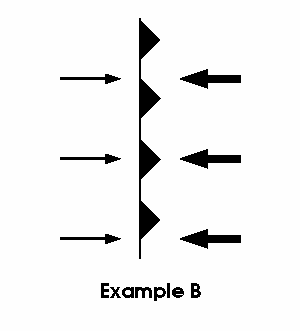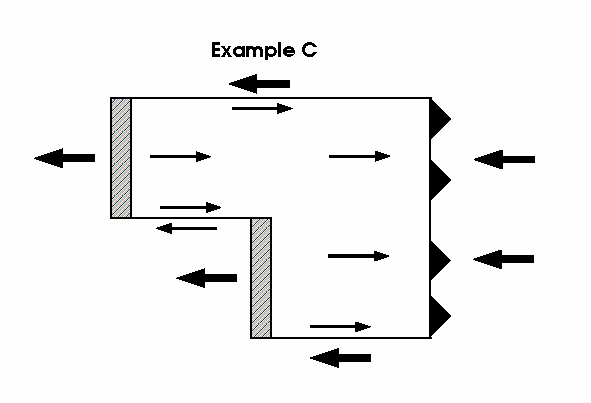ES 10
Handout 2 - Plate Motions on a Flat Earth
Greg Anderson
This handout is designed to give a few examples to explain how to do problem
4 of Homework 3. I
hope it helps clear things up for you. As always, of
course, if you find that you are confused after reading this handout and the
homework, please talk with me after class, come to the discussion section,
or send me e-mail.
My e-mail address is
anderson@python.ucsd.edu.
Look at the figure titled ``Examples for Plate Motion Problem'', shown below:
 You should see some lines, arrows, boxes, and triangles. Each of these has a
specific meaning.
You should see some lines, arrows, boxes, and triangles. Each of these has a
specific meaning.
The shaded rectangular boxes are meant to represent spreading centers,
where the plates move away from each other.
The lines with black triangles
on them are meant to represent subduction zones, where one plate dives
beneath another plate. The triangles are customarily drawn pointing away from
the subduction zone, on the plate which is overriding the other plate.
Straight line segments are meant to represent transform faults,
where two plates simply slide past one another, without either diving or
spreading.
The big heavy arrows are meant to represent plate motion that I
tell you about. The skinny arrows are what I want you to draw in
Homework 3, Problem 4.
In Example A (shown below),
 there are two segments of mid-ocean ridge with a transform fault
between them. I have indicated, using heavy arrows, that there is spreading
going on with the left plate moving left, away from the spreading centers.
However, since these are spreading segments, the other side is also
moving away from the center, to the right in this case. You should draw the
skinny arrows on the right side, pointing away from the spreading centers.
there are two segments of mid-ocean ridge with a transform fault
between them. I have indicated, using heavy arrows, that there is spreading
going on with the left plate moving left, away from the spreading centers.
However, since these are spreading segments, the other side is also
moving away from the center, to the right in this case. You should draw the
skinny arrows on the right side, pointing away from the spreading centers.
At the transform fault, there is a sliding motion, with the upper block sliding
to the right, and the lower block sliding to the left. This is marked by two
arrows, one on top of the other, pointing in opposite directions. That is
how to mark an active transform fault.
In Example B (shown below),
 there is just a subduction zone. The plate to
the right is overriding the plate to the left; I have indicated this with the
heavy arrows on the right side of the subduction zone, pointing toward the
subduction zone. The other plate is also moving toward the subduction zone,
but it is moving toward the right, and hence the skinny arrows.
there is just a subduction zone. The plate to
the right is overriding the plate to the left; I have indicated this with the
heavy arrows on the right side of the subduction zone, pointing toward the
subduction zone. The other plate is also moving toward the subduction zone,
but it is moving toward the right, and hence the skinny arrows.
In Example C (shown below),
 things are a bit more complex. There are two spreading centers,
shown by the shaded rectangles. There is a subduction zone, shown by the line
with triangles. There are also three transform faults, one each at the
top and bottom, and one between the two spreading segments. I have indicated
the motion of the outside plate in heavy arrows: spreading away from the
spreading centers, movement to the left on both the upper and lower transform
faults, and movement toward the subduction zone on the right. You would
draw the skinny arrows showing spreading, sliding along the transform faults
-- all three of them -- and diving into the subduction zone.
things are a bit more complex. There are two spreading centers,
shown by the shaded rectangles. There is a subduction zone, shown by the line
with triangles. There are also three transform faults, one each at the
top and bottom, and one between the two spreading segments. I have indicated
the motion of the outside plate in heavy arrows: spreading away from the
spreading centers, movement to the left on both the upper and lower transform
faults, and movement toward the subduction zone on the right. You would
draw the skinny arrows showing spreading, sliding along the transform faults
-- all three of them -- and diving into the subduction zone.
Greg Anderson
anderson@python.ucsd.edu
Tue Jan 20 13:08:12 PST 1998




